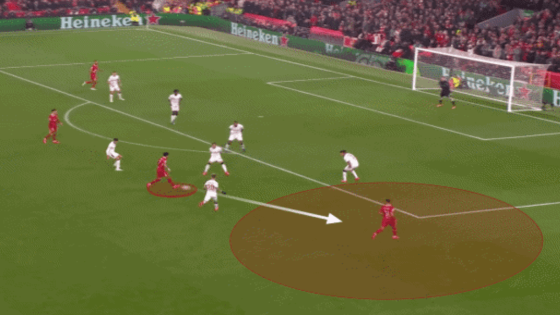Different season, same Mohamed Salah.
Nine goals and nine assists in 16 games in all competitions show how the 32-year-old is in white-hot form.
Questions will continue to swirl around the club until there is greater clarity over Salah’s future — his contract is up in the summer and he is free to negotiate a pre-contract move with a foreign club from January 1 — but there is little doubt his dual-threat from a creative and goalscoring perspective.
As The Athletic has recently analysed, much of Salah’s creativity has been directed towards the back post, with last week’s assists for Cody Gakpo and Luis Diaz against Bayer Leverkusen adding to his suite of services provided to his team-mates from his switched crosses.
When mapping out those assists in all competitions this season, the frequency and potency of those passes to the far post is even more stark.

Salah is being rightfully lauded for his output this season, but there is a clear pattern within those attacking sequences that allow his creative juices to flow — and it comes from underlapping runs by a supporting team-mate.
Arne Slot has admitted that his tactical changes to Liverpool’s stylistic approach have been limited to minimal tweaks, with this attacking arrangement seemingly one of the notable additions. It was a pattern of play that Slot was seen to be working on during open sessions of Liverpool’s pre-season tour of the United States and has only been strengthened in the early months of the campaign.
So, what exactly are we seeing on the pitch? Let’s circle back to those assists against Leverkusen in the Champions League.
As Salah receives the ball from Diaz near the touchline, Trent Alexander-Arnold hares beyond him to drag left centre-back Piero Hincapie back towards his own goal — leaving Salah to drive forward uncontested. After exchanging passes with Diaz again, note the space that Salah has to cross (slide 3 in the GIF below) with Hincapie unable to make up the ground.
It was also the Ecuador international’s foot keeping Gakpo onside for his flying header at the back post — if not for Alexander-Arnold’s off-ball underlapping run, the goal is unlikely to have occurred.

Salah’s second assist followed a similar pattern.
This time, it was substitute Conor Bradley who made a darting run inside, which similarly caught the eye of Hincapie and forced the centre-back to hold a narrow position. As Salah receives the ball from Alexis Mac Allister, Hincapie is not tight enough once again, allowing Salah to find Diaz for another back-post finish.

This has also happened in the Premier League.
A salient example can be seen in Liverpool’s winning goal against Chelsea last month. As Salah receives the ball, Dominik Szoboszlai makes the selfless run to drag Romeo Lavia away from the play — leaving Salah one-v-one with Malo Gusto and able to cut inside to cross for Curtis Jones to finish at the back post.

Szoboszlai had little intention of receiving the ball in this example but was a crucial part of the attacking sequence.
Of course, there are occasions when such an underlapping run is intended to be found — and it can provide a neat through-ball option ahead of the play, allowing the receiver to drive to the byline for a cutback.
This was the case against Brentford, with Alexander-Arnold running on the blindside of left wing-back Kristoffer Ajer to pull the ball back for an onrushing team-mate.

Later in the same game, substitute Bradley makes a near-identical run, which Salah finds before cutting back onto his stronger foot.

Bradley’s athleticism from right-back offers a different skill set to Alexander-Arnold, who is more likely to receive the ball to feet. Salah’s similar ball to find Bradley’s underlapping run was the key pass to his goal below against West Ham United in the Carabao Cup…

Crucially, this sequence of attack is not exclusive to Liverpool’s right flank.
The intelligent runs of Andrew Robertson and Kostas Tsimikas have been a theme of Liverpool’s attack on the left side — and some are more subtle than you think.
Take Gakpo’s equaliser against Brighton. It was a goal that looked a little fortunate after Gakpo’s cross evaded everyone to sneak in at the back post. However, a closer look shows exactly how he found the space in the first place.
As Ryan Gravenberch prepares to pass to Virgil van Dijk, Tsimikas underlaps to make a beeline for Brighton’s full-back Joel Veltman. As Gakpo receives the ball, Tsimikas pins his man, which provides Gakpo with the space to stay one-v-one against Ferdi Kadioglu, and cross (and score) without a challenge.

Liverpool’s left-sided pair also linked up excellently against RB Leipzig, with a one-two seeing Tsimikas underlap Gakpo and cross for Salah to head towards goal — which was finished by Darwin Nunez.

The most obvious example came earlier in the season with a different left-sided pair, but the same approach.
Against Brentford, Robertson underlapped Diaz on several occasions as Liverpool frequently looked to expose the half-space gaps in Thomas Frank’s defence. As a theme across all the examples, some runs were found by Diaz, others acted as decoys to allow the Colombian to come inside onto his stronger foot.

This is not a method of attack that Liverpool are unfamiliar with — as has been highlighted by The Athletic during the 2021-22 season — but Slot has clearly trained a pattern that is working to great effect in his early tenure.
Liverpol’s wingers are thriving individually, but next time you see a well-worked crossing sequence from Salah, Gakpo or Diaz, rewind the tape and check whether an underlapping run opened up the opportunity.





